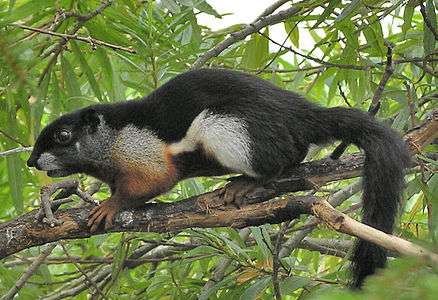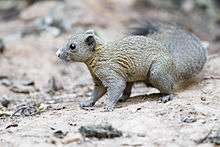Callosciurus
Callosciurus is a genus of squirrels collectively referred to as the "beautiful squirrels". They are found mainly in Southeast Asia, though a few species also occur in Nepal, northeastern India, Bangladesh and southern China.[1] Several of the species have settled on islands. In total, the genus contains 15 species and numerous varieties and subspecies.[1] The genera Glyphotes, Rubrisciurus, and Tamiops have sometimes been included in Callosciurus.
| Callosciurus Temporal range: Early Pleistocene to Recent | |
|---|---|
 | |
| Prevost's squirrel (Callosciurus prevostii) | |
| Scientific classification | |
| Kingdom: | Animalia |
| Phylum: | Chordata |
| Class: | Mammalia |
| Order: | Rodentia |
| Family: | Sciuridae |
| Tribe: | Callosciurini |
| Genus: | Callosciurus Gray, 1867 |
| Species | |
| |
Species
There are approximately 15 species in this genus,[1] and over 60 subspecies. These squirrels range in length from 13 to 27 cm (5.1 to 10.6 in), not including the tail which is often about the same length as the body.[2][3] Most are rather dull olive-brown to gray and several have a pale and dark stripe on their side, however a few are very colorful.[2] The Pallas squirrel may have an unremarkable olive-gray back, while its belly is often –but not always– bright red.[4] The "typical" subspecies of Prevost's squirrels have black backs, white sides, and red-brown undersides. The Finlayson's squirrel occurs in numerous varieties, three of which are overall red-brown, overall black, or pure white.[2]
Most squirrels in Callosciurus live in tropical rain forests, but some individuals live in parks and gardens in cities. In the trees, they build their nests out of plant material. They are solitary, and give birth to one to five young. Their food consists of nuts, fruits, and seeds, and also of insects and bird eggs.
| Image | Scientific name | Common name | Description | Distribution |
|---|---|---|---|---|
| Callosciurus quinquestriatus | Anderson's squirrel | Made up of two subspecies, C. q. quinqestriatus andC. q. imarius.[5] This species is listed as "Near Threatened" by the IUCN due to habitat loss.[6] | China and Myanmar | |
| Callosciurus nigrovittatus | black-striped squirrel | This taxon consists of four subspecies: C. n. nigrovittatus, C. n. bilimitatus, C. n. bocki, and C. n. klossi.[5] It is listed as "Near Threatened" by the IUCN.[7] | Java, Sumatra, southern Thailand, the Malay Peninsula, and numerous small islands | |
.jpg) | Callosciurus orestes | Borneo black-banded squirrel | Listed as "Least Concern" by the IUCN.[8] | Endemic to northern Borneo |
 | Callosciurus adamsi | ear-spot squirrel | Listed as "Vulnerable" by the IUCN.[1][9] | northern Borneo |
.jpg) | Callosciurus finlaysonii, misspelled C. finlaysoni | Finlayson's squirrel, variable squirrel | Cambodia, Laos, Myanmar, Thailand, and Vietnam. | |
 | Callosciurus caniceps | Grey-bellied squirrel | consist of six subspecies found in forests, plantations and gardens | Peninsular Malaysia, Thailand, southern Myanmar, southern China (Yunnan) and possibly western Laos.[10] |
| Callosciurus honkhoaiensis | Hon Khoai squirrel | First described in 2018, it is a dwarf species related to the grey-bellied squirrel, from which it probably diverged during the Pliocene.[11] | found only on Hon Khoai island off the southern tip of Vietnam | |
| Callosciurus inornatus | inornate squirrel | This squirrel was once considered a subspecies of Callosciurus pygerythrus, and as a result several texts inaccurately cite C. pygerythrus as being found in these areas.[12] The reclassification was based on different fur characteristics, placing it closer in relation to C. caniceps.[12][13] It is listed as "Least Concern" by IUCN.[12] | distributed across Laos, Vietnam, and the Chinese province of Yunnan. | |
 | Callosciurus pygerythrus | Irrawaddy squirrel | Made up of seven subspecies | found throughout Bangladesh, China, India, Myanmar, and Nepal.[5][14] |
| Callosciurus baluensis | Kinabalu squirrel | Its tail and upperparts are grizzled blackish, the underparts are reddish-orange, and the flanks have a narrow buff stripe with a broader black stripe below.[3] This species is listed as "Least Concern" by the IUCN.[15] | endemic to northeastern Borneo, specifically the wide area around Mount Kinabalu.[1] | |
| Callosciurus albescens | Kloss's squirrel | population data is insufficient to assess its endangerment status according to the IUCN.[1][16] It is debated whether it is a subspecies of C. notatus, which would make Kloss's squirrel instead be named C. notatus albescens. | endemic to northern Sumatra | |
| Callosciurus melanogaster | Mentawai squirrel | It is further dived into three subspecies: C. m. melanogaster, C. m. mentawi, and C. m. atratus.[5] This small isolated population is listed as "Vulnerable" by the IUCN due to habitat loss.[17] | native to the Mentawai Islands off the west coast of Sumatra | |
| Callosciurus phayrei | Phayre's squirrel | listed as "Least Concern" by the IUCN.[1][18] | found in China and southern Myanmar | |
 | Callosciurus notatus | plantain squirrel | found in a wide range of habitats: forests, mangroves, parks, gardens, agricultural areas | Indonesia, Malaysia, Singapore and Thailand |
.jpg) | Callosciurus prevostii | Prevost's squirrel, Asian tri-colored squirrel | forest in the Thai-Malay Peninsula, Sumatra, Borneo and nearby smaller islands, with an introduced population in northern Sulawesi. | |
_2.jpg) | Callosciurus erythraeus | Pallas's squirrel, red-bellied tree squirrel | Greater China, India, and Southeast Asia. | |
References
- Thorington, R.W., Jr.; Hoffmann, R.S. (2005). "Family Sciuridae: Genus Callosciurus". In Wilson, D.E.; Reeder, D.M (eds.). Mammal Species of the World: a taxonomic and geographic reference (3rd ed.). The Johns Hopkins University Press. ISBN 978-0-8018-8221-0. OCLC 26158608.
- Francis, C. M. (2008). A Guide to the Mammals of Southeast Asia. ISBN 978-0-691-13551-9
- Payne, J., and C. M. Francis (1985), A Field Guide to the Mammals of Borneo. ISBN 967-99947-1-6
- Smith, T. S., and Y. Xie, editors (2008). A Guide to the Mammals of China. ISBN 978-0-691-09984-2
- Thorington, R.W., Jr.; Hoffmann, R.S. (2005). "Family Sciuridae". In Wilson, D.E.; Reeder, D.M (eds.). Mammal Species of the World: a taxonomic and geographic reference (3rd ed.). The Johns Hopkins University Press. pp. 754–818. ISBN 978-0-8018-8221-0. OCLC 26158608.
- Lunde, D.; Duckworth, J. W.; Lee, B. & Tizard, R. J. (2008). "Callosciurus quinquestriatus". IUCN Red List of Threatened Species. 2008: e.T3605A9977678. doi:10.2305/IUCN.UK.2008.RLTS.T3605A9977678.en. Retrieved 11 January 2018.
- Duckworth, J. W.; Lee, B. & Tizard, R. J. (2008). "Callosciurus nigrovittatus". IUCN Red List of Threatened Species. 2008: e.T3599A9967361. doi:10.2305/IUCN.UK.2008.RLTS.T3599A9967361.en. Retrieved 11 January 2018.
- Duckworth, J. W.; Lee, B. & Tizard, R. J. (2008). "Callosciurus orestes". IUCN Red List of Threatened Species. 2008. Retrieved 6 January 2009.CS1 maint: ref=harv (link)
- Duckworth, J. W. & Meijaard, E. (2008). "Callosciurus adamsi". IUCN Red List of Threatened Species. 2008. Retrieved 6 January 2009.CS1 maint: ref=harv (link)
- Duckworth, J. W. (2008). "Callosciurus caniceps". IUCN Red List of Threatened Species. 2008. Retrieved 6 January 2009.CS1 maint: ref=harv (link)
- Nguyen, Son Truong; Oshida, Tatsuo; Dang, Phuong Huy; Bui, Hai Tuan; Motokawa, Masaharu (June 2018). "A new species of squirrel (Sciuridae:Callosciurus) from an isolated island off the Indochina Peninsula in southern Vietnam". Journal of Mammalogy. 99 (4): 813–825. doi:10.1093/jmammal/gyy061.
- Duckworth, J. W. & Timmins, R. J. (2008). "Callosciurus inornatus". IUCN Red List of Threatened Species. 2008. Retrieved 6 January 2009.CS1 maint: ref=harv (link)
- Corbet and Hill, 1992
- Shrestha, N.; Sarkar, S. K.; Lunde, D.; Duckworth, J. W.; Lee, B.; Tizard, R. J. & Molur, S. (2008). "Callosciurus pygerythrus". IUCN Red List of Threatened Species. 2008. Retrieved 6 January 2009.CS1 maint: ref=harv (link)
- Duckworth, J. W.; Meijaard, E. & Gumal, M. (2008). "Callosciurus baluensis". IUCN Red List of Threatened Species. 2008. Retrieved 6 January 2009.CS1 maint: ref=harv (link)
- Meijaard, E. & van Strien, N. J. (2008). "Callosciurus albescens". IUCN Red List of Threatened Species. 2008. Retrieved 6 January 2009.CS1 maint: ref=harv (link)
- Lunde, D.; Duckworth, J. W.; Lee, B. & Tizard, R. J. (2008). "Callosciurus melanogaster". IUCN Red List of Threatened Species. 2008. Retrieved 6 January 2009.CS1 maint: ref=harv (link)
- Chiozza, F. (2008). "Callosciurus phayrei". IUCN Red List of Threatened Species. 2008. Retrieved 6 January 2009.CS1 maint: ref=harv (link)
- Ronald M. Nowak: Walker's Mammals of the World. Johns Hopkins University Press, 1999 ISBN 0-8018-5789-9
- Ecology Asia page with photos and description.
- Wildlife Singapore Photos and description
- Ecology Asia Photos and description
External links
| Wikimedia Commons has media related to Callosciurus. |
- Squirrels of Southeast Asia
- Photo gallery showing some of the variations of the Gray-bellied Squirrel
- Photo gallery showing some of the variations of Finlayson's Squirrel
- Profile at ecologyasia.com
- Profile at wildsingapore.per.sg